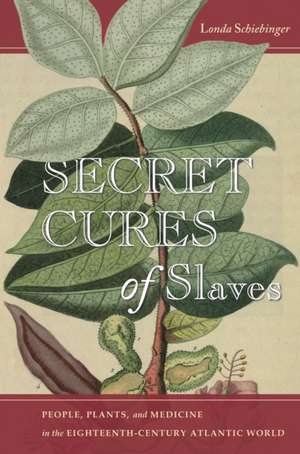Secret Cures of Slaves – People, Plants, and Medicine in the Eighteenth–Century Atlantic World
Autor Londa Schiebingeren Limba Engleză Paperback – 24 iul 2017
| Toate formatele și edițiile | Preț | Express |
|---|---|---|
| Paperback (1) | 166.57 lei 3-5 săpt. | |
| MK – Stanford University Press – 24 iul 2017 | 166.57 lei 3-5 săpt. | |
| Hardback (1) | 623.36 lei 6-8 săpt. | |
| MK – Stanford University Press – 24 iul 2017 | 623.36 lei 6-8 săpt. |
Preț: 166.57 lei
Nou
Puncte Express: 250
Preț estimativ în valută:
31.88€ • 33.15$ • 26.68£
31.88€ • 33.15$ • 26.68£
Carte disponibilă
Livrare economică 21 februarie-07 martie
Preluare comenzi: 021 569.72.76
Specificații
ISBN-13: 9781503602915
ISBN-10: 1503602915
Pagini: 256
Dimensiuni: 178 x 254 x 14 mm
Greutate: 0.5 kg
Editura: MK – Stanford University Press
ISBN-10: 1503602915
Pagini: 256
Dimensiuni: 178 x 254 x 14 mm
Greutate: 0.5 kg
Editura: MK – Stanford University Press
Cuprins
Contents and Abstracts
Introduction
chapter abstract
To what extent were slaves exploited in eighteenth-century medical experiments? To answer this question, The Secret Cures of Slaves develops a taxonomy of the varieties of experiments within the context of eighteenth-century medical ethics: exploitative (taking undue risk with human life) versus nonexploitative (testing with care in the group likely to benefit from the cure); invasive versus noninvasive; therapeutic to the individual involved versus nontherapeutic. Today informed consent would also be a key consideration in judging the exploitative nature of experiments. This, however, was not the case for experimental populations¿the poor, soldiers, sailors, or slaves¿in the eighteenth century. It was enough that physicians judged a treatment in a subject's best interest. Although patient consent was not required, physicians often complied with patients' or parents' wishes.1The Rise of Scientific Medicine
chapter abstract
Chapter 1 traces the rise of experimental medicine in Europe and how this translated to Europe's West Indian colonies. It focuses on how race was investigated in two sets of experiments. The first by Jamaican physician James Thomson, sought to identify anatomical and physiological differences between races. Engaging in a grotesque set of experiments to understand skin color through dissection of persons of African origin, Thomson sought to locate the ultimate physiological source of blackness in human skin. The second set of experiments by Colin Chisholm, inspector general for troops in the British West Indies, designed experiments to understand core body heat in humans across temperature zones. Chisholm's study included race as a biological variable, but his focus was "place," specifically patients' birth and immigration status. Employing newly developed medical thermometers, Chisholm experiments were designed to answer questions crucial to the colonial enterprise.2Experiments with the Negro Dr's Materia Medica
chapter abstract
Chapter 2 turns to experiments to test a cure for yaws that A. J. Alexander learned from one of his enslaved Africans. One of my purposes in this book is to expand our knowledge of African contributions to science. Alexander considered his slave's cure for yaws "Negro Materia Medica." One question explored here is whether Africans brought their medicines and techniques with them from their homelands or whether they experimented with new plants and cures found in the West Indies. This raises methodological questions about how to trace the circulation of knowledge in the Atlantic World. This chapter explores evidence for the provenance of the cure that Alexander learned from his slave. When historical documents fail, what can the plants tell us? Were the plants employed in cures indigenous to Africa, the Americas, or both?3Medical Ethics
chapter abstract
Chapter 3 investigates eighteenth-century ethical brakes to medical experiments in the Atlantic World. The first section looks at ethics in Europe; the second at ethics in the Caribbean. The question is: Did experiments with slaves give birth to new debates and discussion? Did slaves become an exploited or a protected category?4Exploitative Experiments
chapter abstract
Chapter 4 focuses on the exploitation of slave bodies in eighteenth-century medical experiments, primarily in John Quier's experiments with smallpox inoculation and James Thomson's inoculations with yaws, both in Jamaica. These physicians took risks beyond what was reasonable to treat the individual patient; they took unusual liberties with human bodies. Yet masters had the final word in decisions concerning their slaves. There was no issue of slave consent¿or, for that matter, often physician consent.5The Colonial Crucible: Debates over Slavery
chapter abstract
Chapter 5 pulls out to a larger frame to understand the violence and fears endemic to colonial struggles. This chapter explores aspects of African medicine that were not put to test, such as Obeah, developed by slaves in the British West Indies. Europeans were interested in the material aspects of African healing traditions¿the specific herbs or bathing techniques¿but they shied away from the spiritual or mystical aspects of Obeah, for example. This is surprising, since European physicians understood the potential benefits of what we today call the placebo effect.Conclusion: The Circulation of Knowledge
chapter abstract
The flow of knowledge in the Atlantic World medical complex was promiscuous and multidirectional. Knowledge had its origins with Amerindians, persons of African origins, and persons of European origins (in both Europe and its far-flung colonies). These knowledges mixed in the Caribbean plantation complex as Europeans frantically sought to develop tropical medicine to combat the ravages of colonial disease. This chapter identifies three major nexuses across which people and their knowledges moved: the colonial nexus linking Europe and the Americas, the slave trade nexus joining Africa and the Americas, and the conquest nexus that brought Amerindian practices into the plantation complex.Notă biografică
Londa Schiebinger is the John L. Hinds Professor of History of Science at Stanford University. She is the author of the award-winning Plants and Empire: Colonial Bioprospecting in the Atlantic World (2004), among many other works.
Descriere
This book explores the history of drug development and testing in the eighteenth-century Atlantic World, looking especially at whether slaves were exploited in human medical experiments at the time.
